Since taking over in the middle of April, Lucas Pusineri has taken Atlético Tucumán to new heights. After finishing in 25th place last season, – a spot that would have seen them relegated in any other non-COVID year – Tucumán are now surprisingly challenging for the Liga Profesional de Fútbol title.
The side based in the city of San Miguel de Tucumán have never won the Argentinian first division, but after 120 years of existence, they finally have a real chance to do so. With five matches to go, El Decano currently sit in second place, only one point behind Boca Juniors. Additionally, aside from a match against Racing Club, they have a fairly easy run of games to end the season. While they depend on Boca to drop points, the title is closer than ever.
Considering Atlético Tucumán have nowhere near the budget or quality of the likes of Boca Juniors and River Plate, Lucas Pusineri’s work so far is extremely impressive. Unable to dominate matches like Real Madrid or Barcelona normally would, Pusineri has resorted to Atlético Madrid-style tactics.
This tactical analysis explores Atlético Tucumán’s successful tactics under Lucas Pusineri. With an unusual playing style, this analysis aims to understand how Pusineri has led a small club from San Miguel de Tucumán to go toe-to-toe with Argentina’s biggest clubs.
Formations
El Gigante del Norte have traditional tactics, and with such, a traditional formation. In 2022, Atlético Tucumán used a 4-4-2 47% of the time. For another 31% of the time, they have varied between a 4-1-3-2 and a 4-3-1-2, both extremely narrow formations. This variation has become more common under Pusineri, where the two distinct systems are used depending on the opponent’s structure.
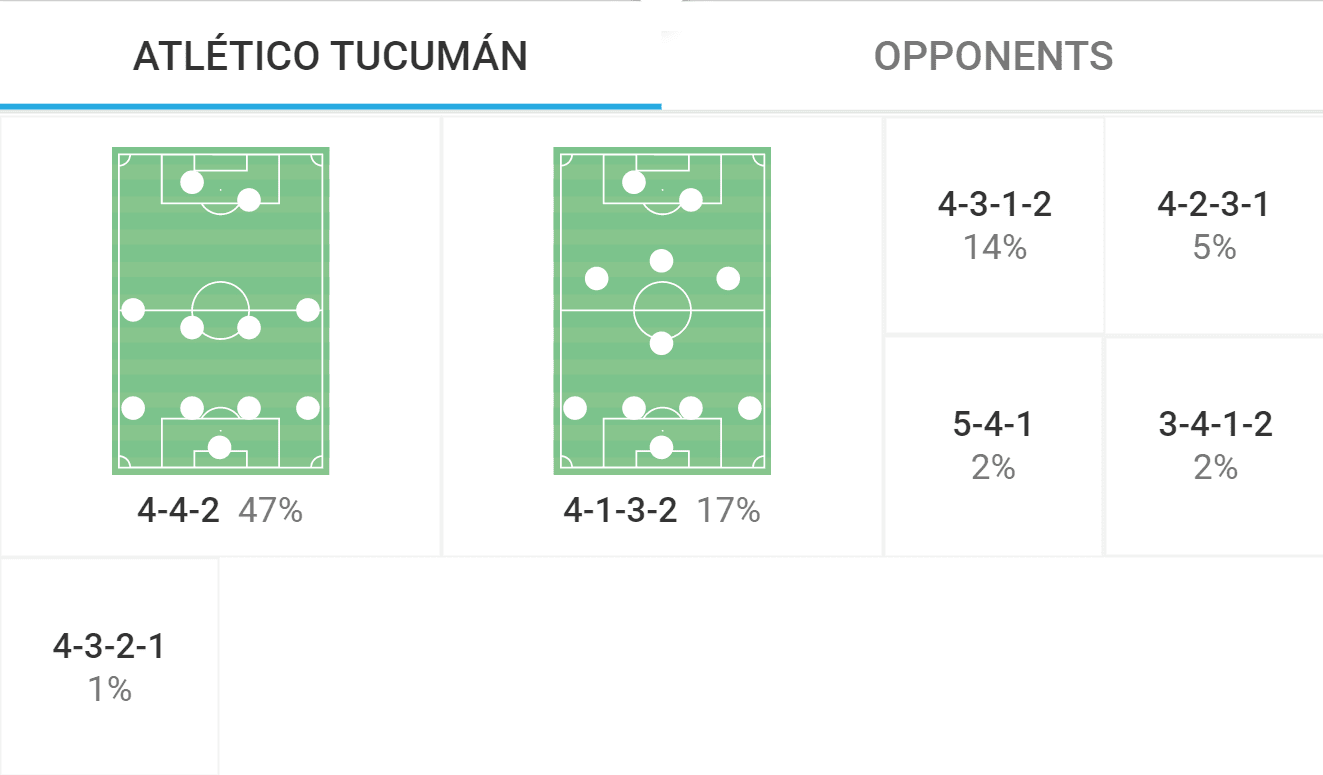
The 4-4-2 is a fairly simple and straightforward structure which allows Tucumán to easily transition between phases of play. Additionally, as a team that likes to sit in low blocks for long periods of time, it is an ideal defensive structure. As far as line-ups go, Pusineri has been fairly consistent. Aside from a few changes here and there, the 46-year-old manager has stuck to the same players.
Low blocks
Tucumán’s tactics are far from possession-based. In 2022, El Decano have only averaged 45.44% possession. Similarly, they average 341.92 passes per 90. These are fairly low figures for a side currently challenging for the title. Tucumán’s success, consequently, comes from their work out of possession. Despite not having much of the ball, they only concede 10.22 shots per 90. Additionally, these 10.22 shots only amount to 0.95 xGA per 90 or 0.093 xGA per shot. El Gigante del Norte are extremely comfortable sitting in low blocks and defending deep. They are able to defend for long periods of time without conceding high-quality opportunities.
While their verticality is certainly a factor for such a low possession figure, their defensive intensity is perhaps the biggest one. Atlético Tucumán sit bottom of the league for both challenge intensity and PPDA. Rather than beginning their defensive work with an intense high block, as most successful teams would, Pusineri’s side tend to sit in lower blocks and attract the opposition.
These lower blocks consist of two compact lines of four in their usual 4-4-2 structure. With the wide players having an incredibly significant role in the defensive phase, Tucumán get everyone behind the ball with the aim of minimising the opposition’s playing area.
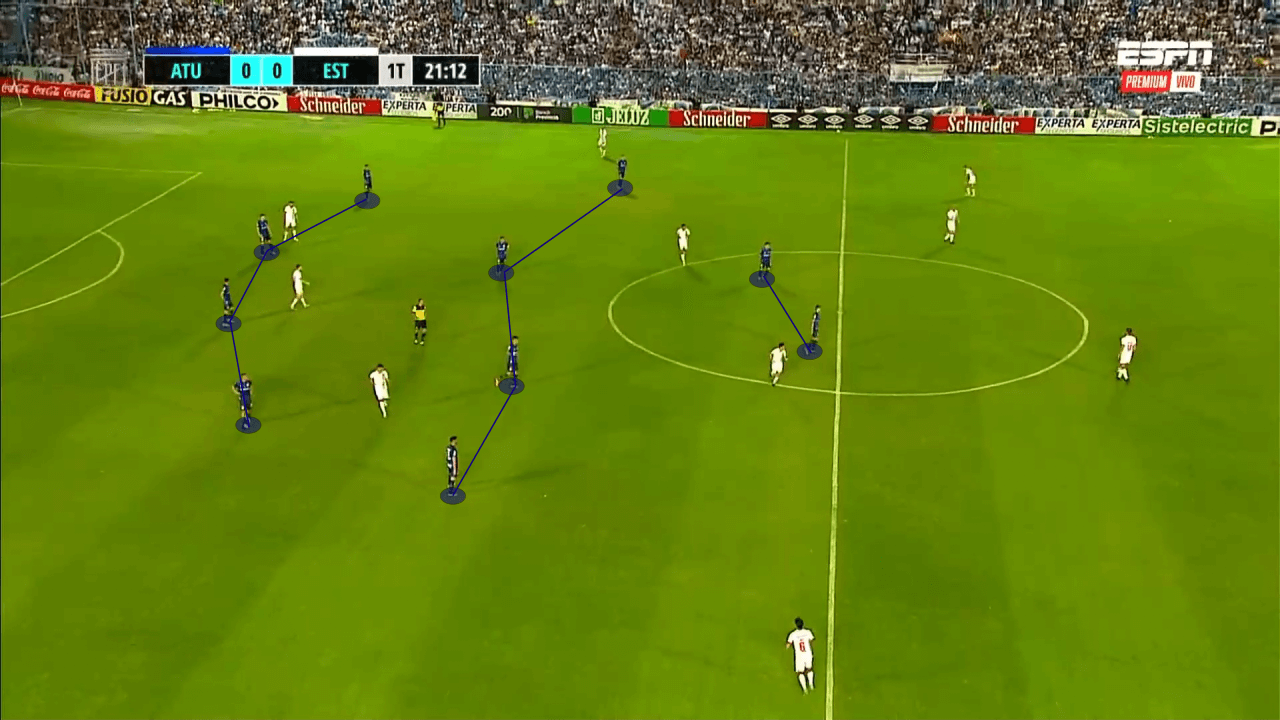
There are a couple of principles that allow Pusineri’s side to carry out a low block with such efficiency and security. The most significant one, however, is their ability to remain compact. Regardless of the height of the block, they will remain extremely compact, both in width and depth. In the instance below, they begin the match with a more advanced structure. As the opposition player enters the midfield, he is immediately surrounded by four Tucumán players, a result of their proximity to one another.
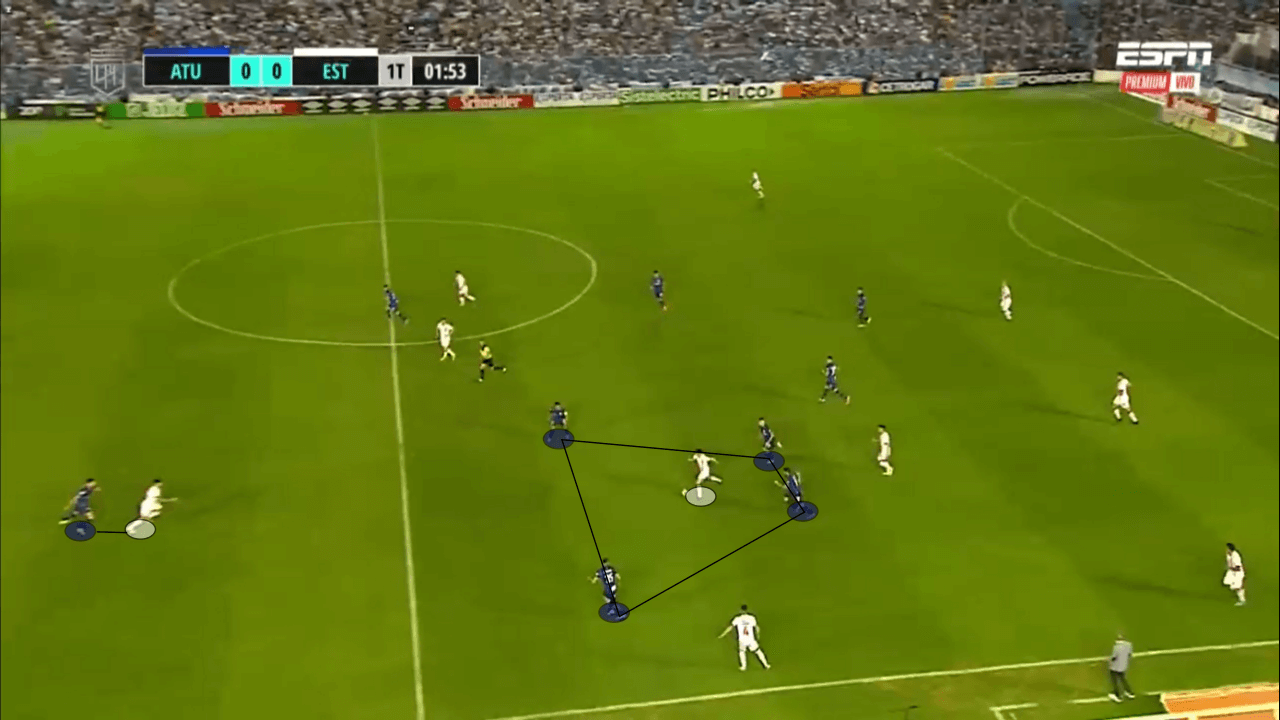
Remaining compact is especially important in a mid-to-low block. As they aim to keep the opposition from effectively entering the final third, they compress their defensive structure. In the example below, it is especially notable how narrow their structure is. With both wide players coming in, they concentrate eight players in the central channels. As the opposition aims to progress forward, Pusineri’s men immediately surround and overwhelm them.
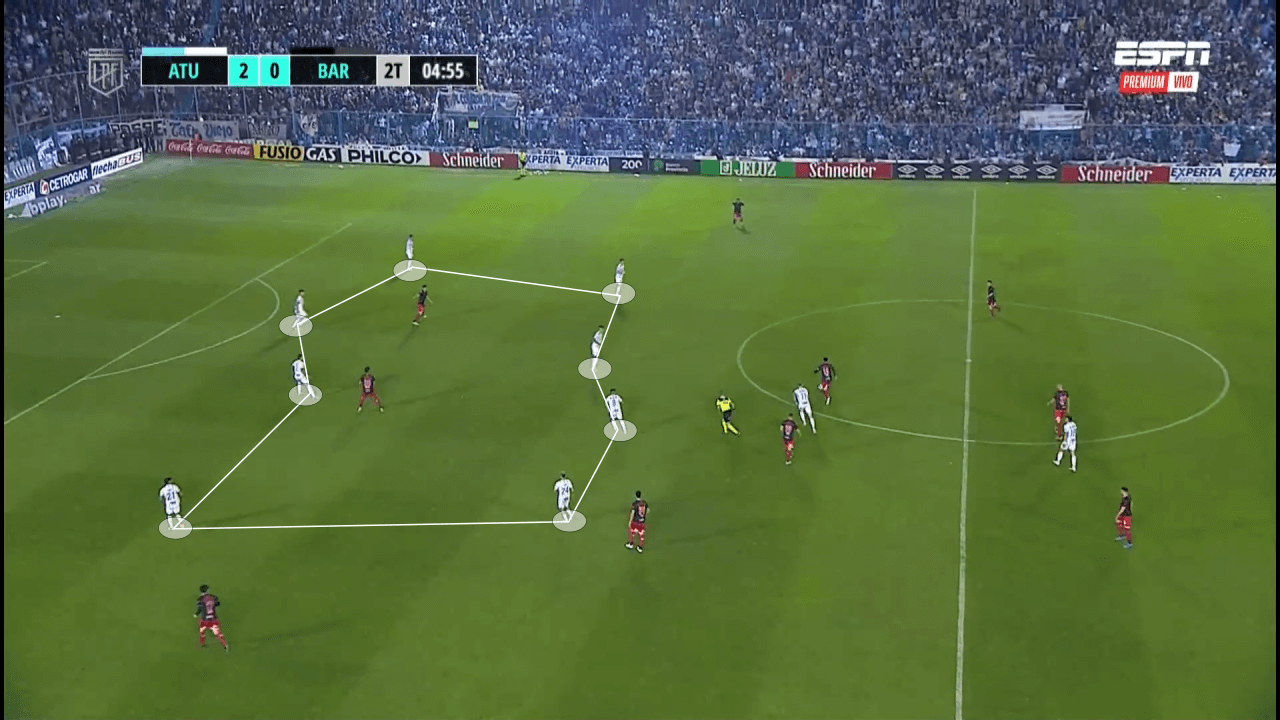
This compactness takes us to the next principle that allows for such an effective defensive system. Numerical superiority. With the ball as a reference point, Tucumán aim to constantly have numerical superiority in a specific area. With the 4-4-2 being such a balanced and dynamic structure, they are constantly able to do this with success, both wide and centrally.
In the example below, as San Lorenzo try to create through the left wing, Tucumán are able to create a 4v3 scenario and regain possession. With the nearest midfielder and centre-forward being able to provide support, they are easily able to overwhelm the wide areas and create favourable scenarios.
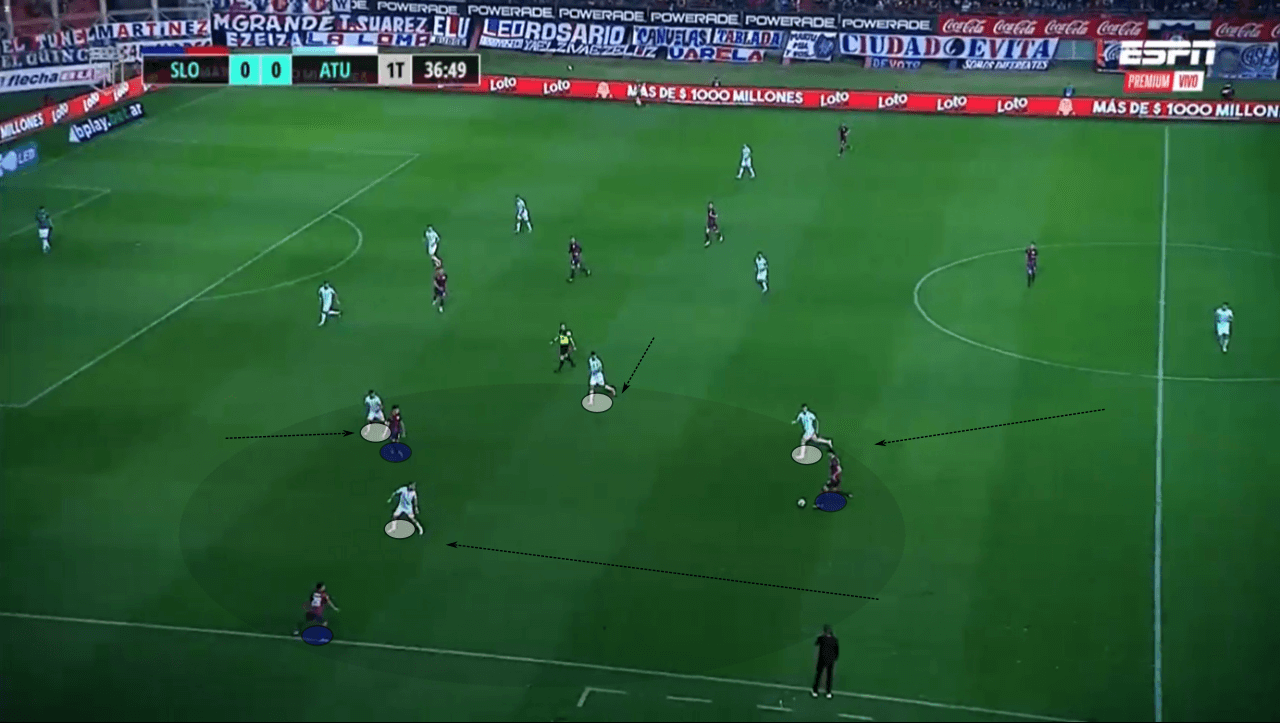
While in theory principles like superiority and compactness are crucial to an effective low block, football is a live and dynamic game. The tempo is high, and the pieces are constantly moving. Consequently, effective coordination and movement are essential to carrying out a successful low-block strategy.
This coordination takes place through seamless movement and rotations. As the opposition attempts to disorganise the defensive structure and create space through mobility, it is important to remain organised. The example below perfectly illustrates all these principles. Initially, the opposition attempts to create through the left wing, but Tucumán create a 3v2 superiority and keep them from progressing. As they recycle to the other end, Pusineri’s players perform various rotations.
The wide players communicate to decide who steps up to the ball carrier and who remains marking the wide player. Additionally, one midfielder also rushes to pressure the ball carrier while the other provides cover. These sorts of coordinated movements are essential in keeping the opposition from creating space and progressing forward.
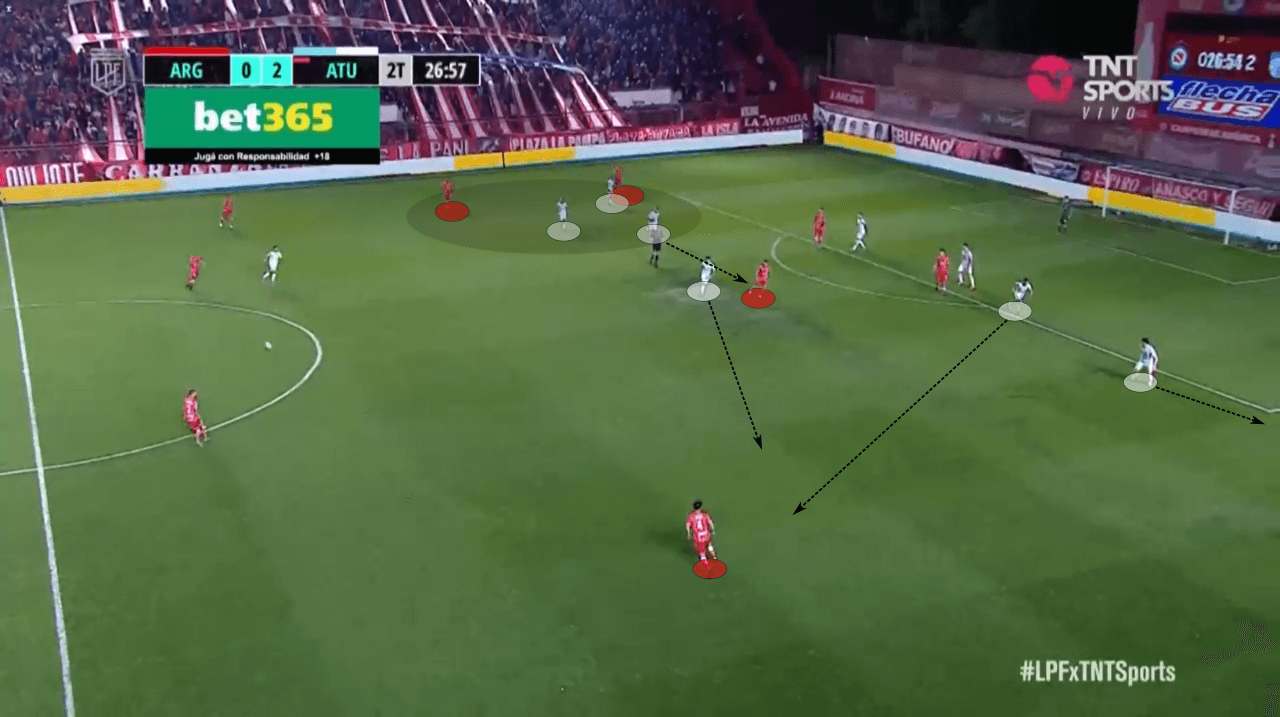
Transitions
El Decano’s defensive system is a key part of their attacking strategy. A significant amount of their goals come from quick and lethal offensive transitions. By sitting in deep low blocks, they force the opposition to commit players forward and naturally become more vulnerable. After recovering the ball, they are extremely effective in quickly getting out and exploring the chaos that is an offensive transition.
Using an example explored in the previous section, we can further understand how their defensive organisation allows them to be such a dangerous threat in transition. Upon recovering the ball, Tucumán have three players in that immediate area. With such numbers, they are able to play out and quickly launch a counterattack to exploit the opposition’s high line.
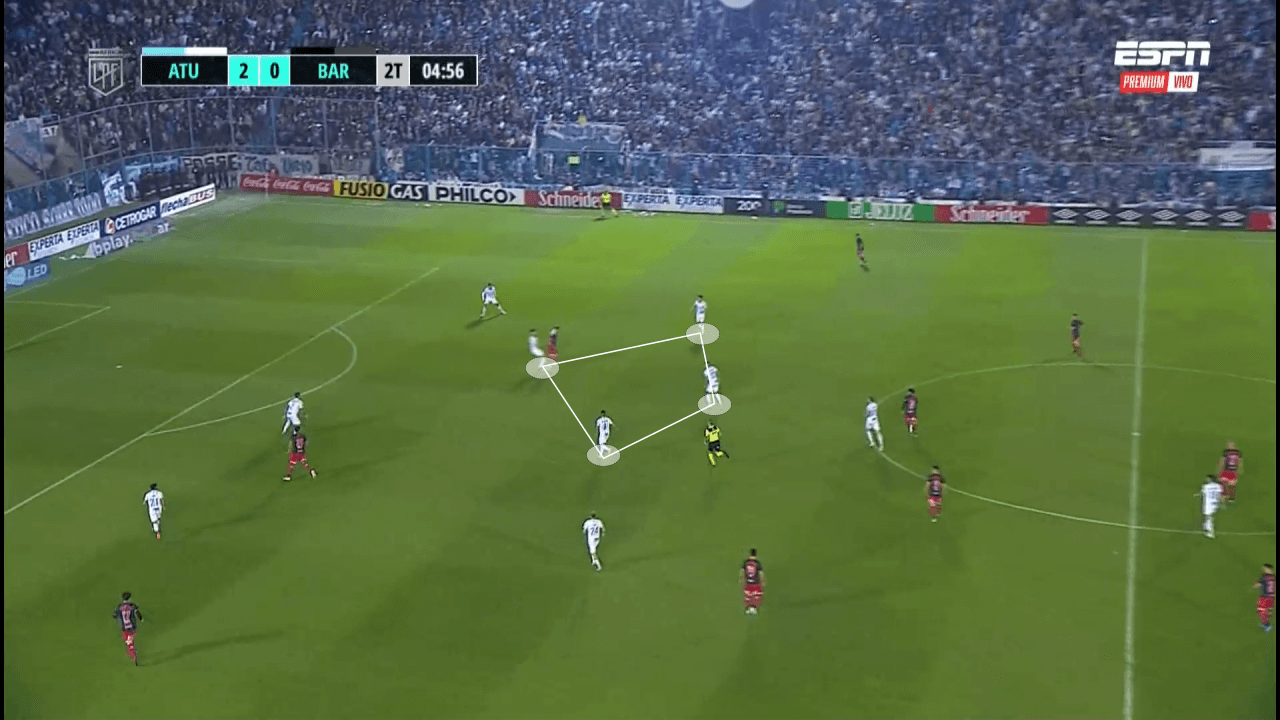
The number of players they tend to commit to these transition scenarios is another part of their success. By throwing players forward, they are able to manipulate a disorganised defensive structure with coordinated movements and create numerous passing options. In the instance below, Tucumán immediately launch six players forward after recovering the ball.
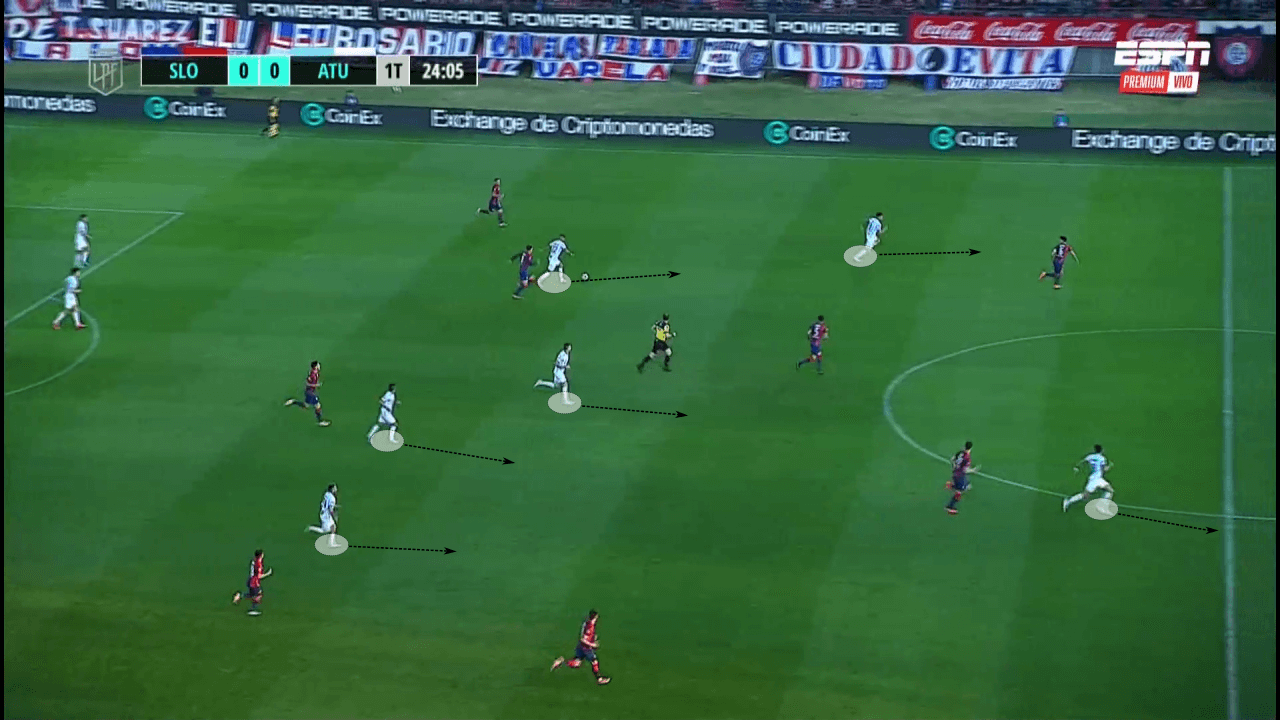
These transitions can come through either short combinations or quick vertical passes. In the instance below, they play two quick direct passes to progress from their own third to the final third.
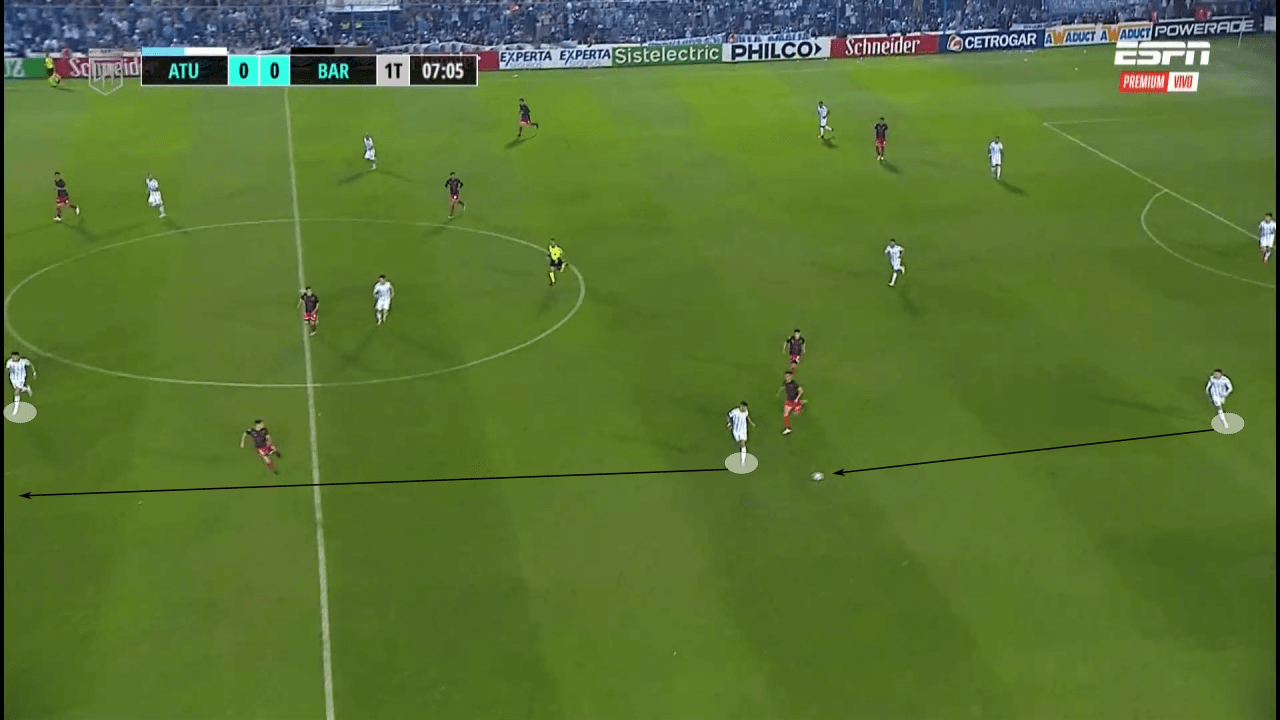
In another example, we are able to see how they launch quick transitions through intelligent combinations. After recovering the ball, Tucumán’s player plays it long to the centre-forward who lays off the right winger. After receiving it, the winger plays a through pass for a central midfielder coming from deep. These sorts of coordinated movements and combinations are what make Tucumán so lethal in transitions.
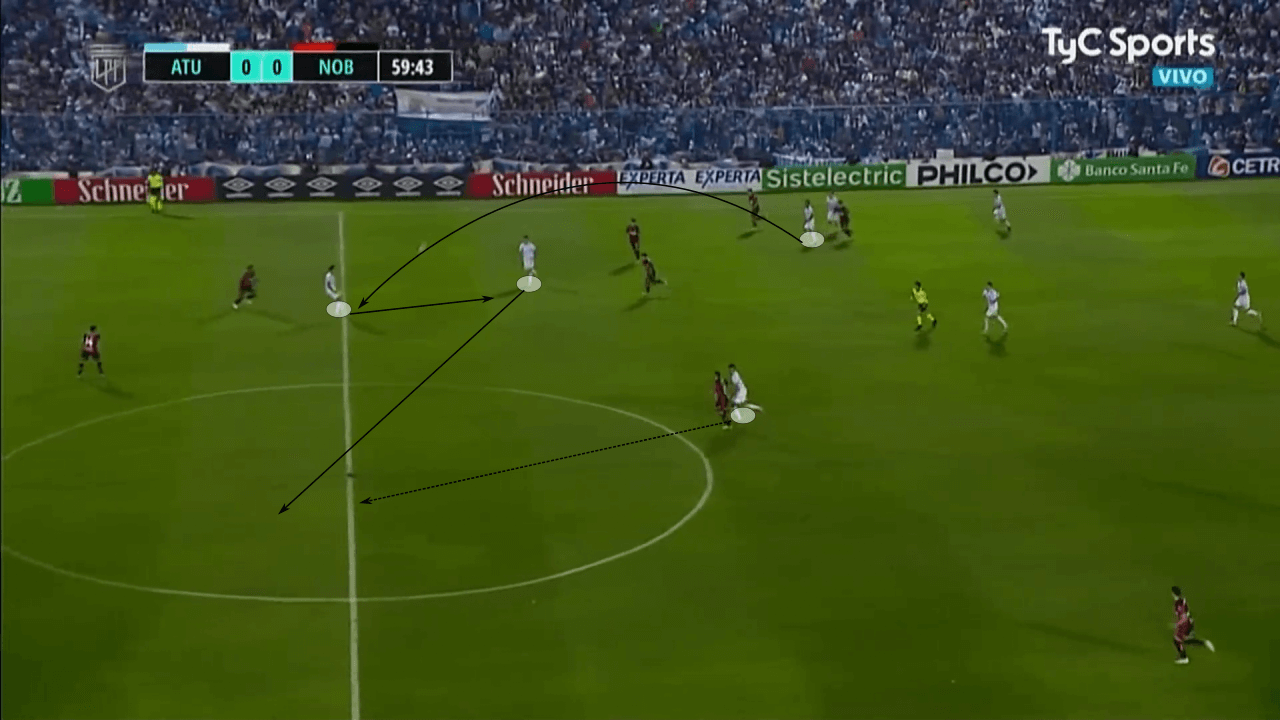
Verticality
In possession, Pusineri’s side maintains a similar playing style. With such a passive defensive strategy, they will naturally have very little of the ball. Consequently, they must be incredibly efficient when they do have the ball. They choose to do this through a direct and vertical approach. From their 341.92 passes per 90, 72.03 are progressive passes. More clearly, they average more forward passes (137.32 per 90) than lateral passes (114.32 per 90). Tucumán are constantly looking to play forward and take risks.
In 2022, a significant 16.66% of their passes have been long. They are constantly looking to quickly progress through the zones in a vertical manner, and they do so by stretching the opposition out and creating large amounts of space.
In the build-up, their 4-4-2 turns into a 4-2-4. With the wingers sitting in the same line as the centre-forwards, they pin the opposition’s backline high and wide. By doing so, they maximise the playing area and stretch the defensive organisation.
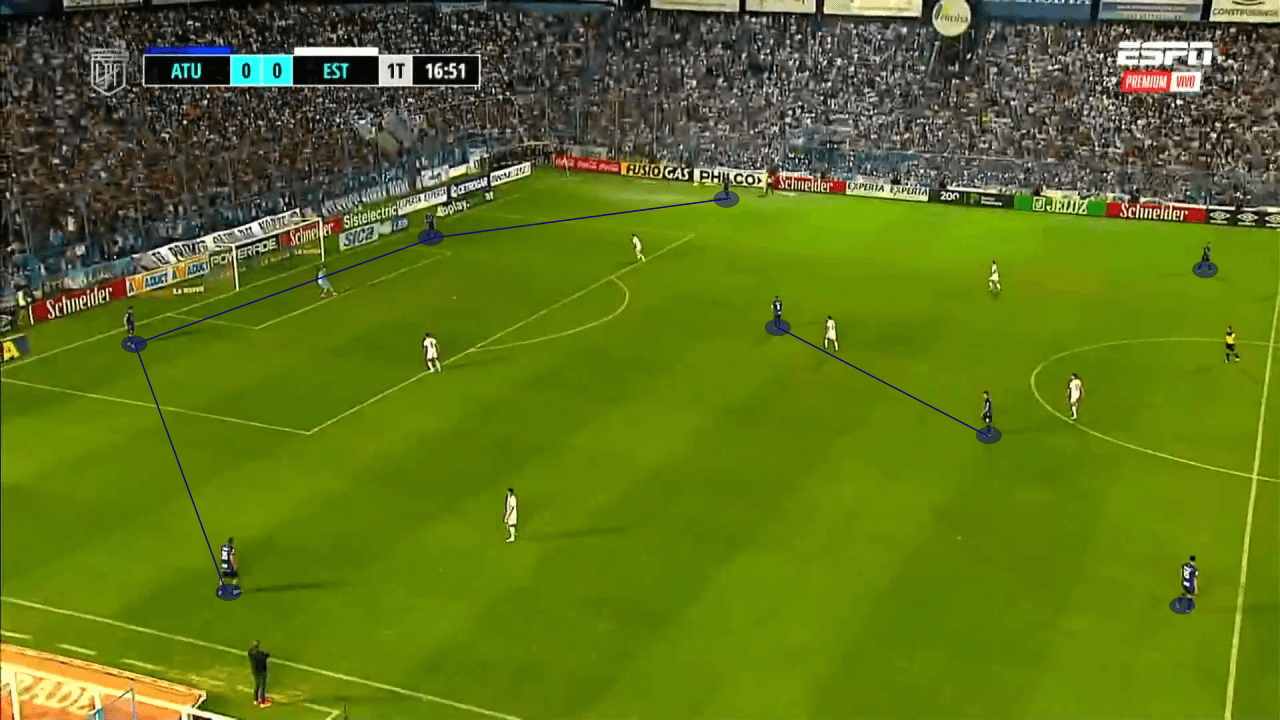
After stretching the defence and increasing the space available, they look for long and vertical passes reaching the attackers. In the example below, one of the midfielders drops deep to drag the opposition’s midfield forward and create space for the attackers to drop into.
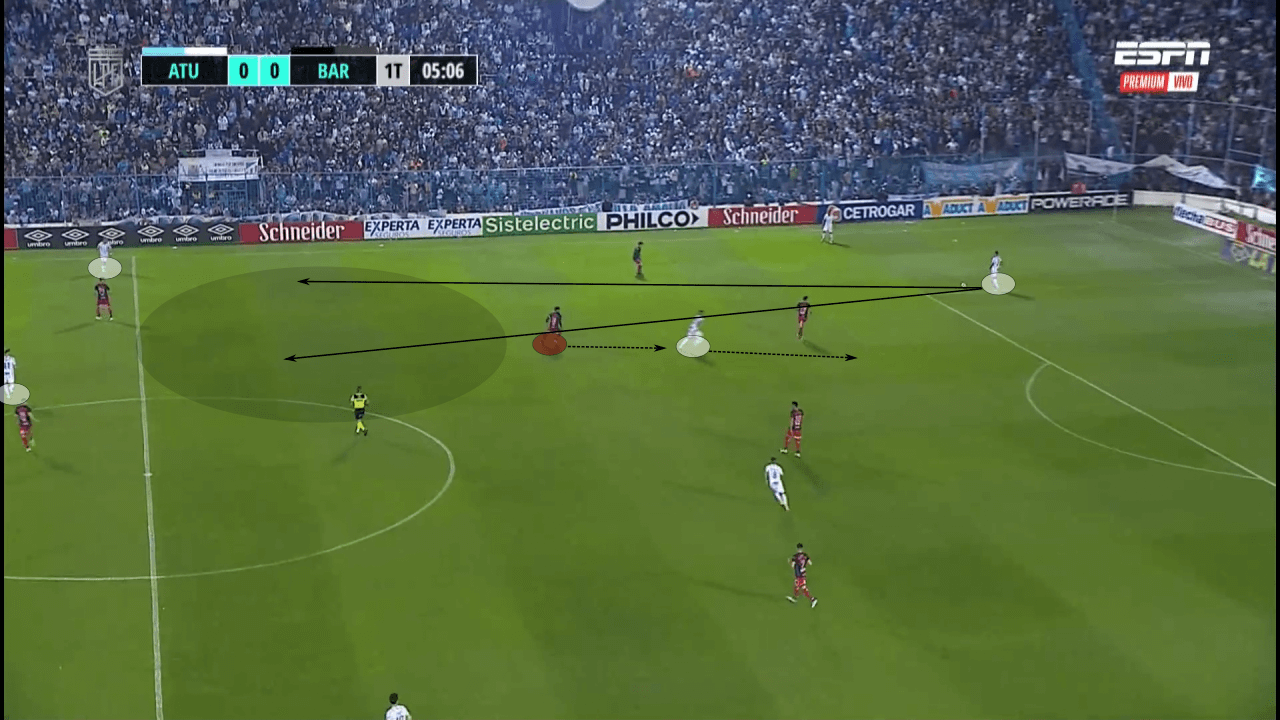
The four attacking players are responsible for constantly making runs into the space behind, especially against higher defensive blocks. In the instance below, one of the centre-forward checks in before quickly spinning off and making a run in behind. This constant movement among the front four is what allows for such an effective vertical approach.
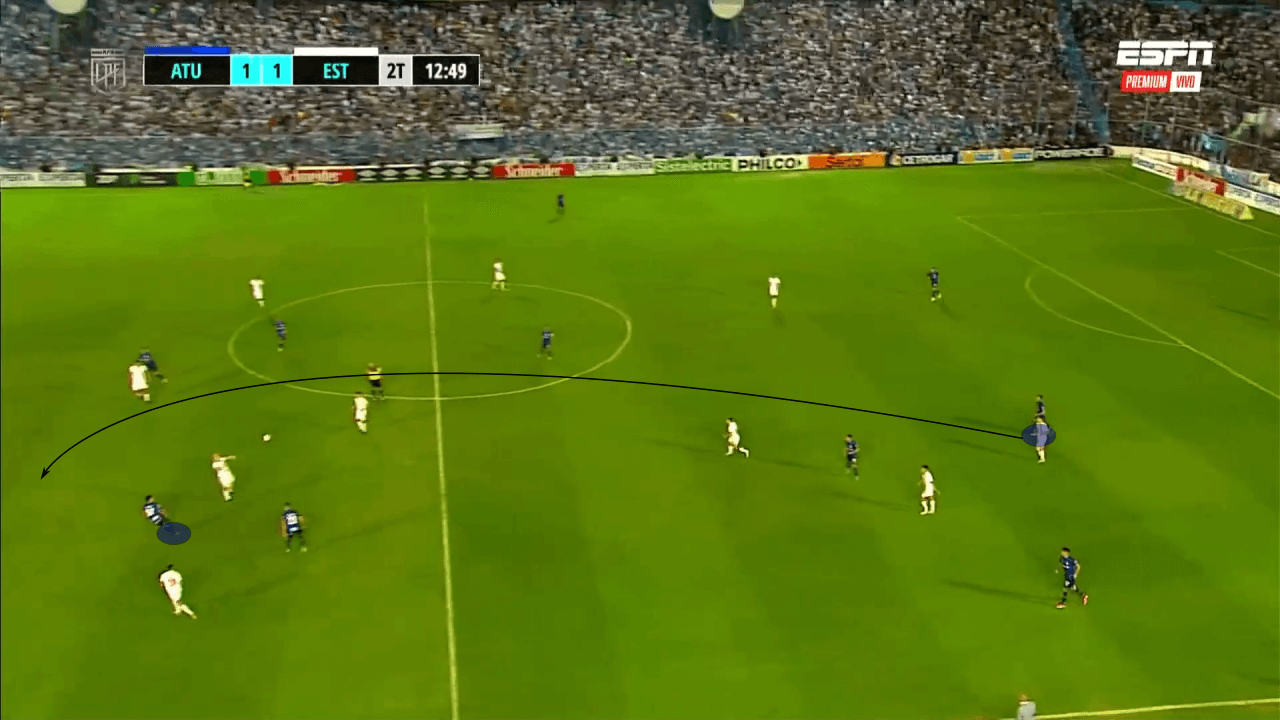
Manuel Capasso’s pass map further illustrates and represents Tucumán’s strategy with the ball. While a significant portion of them are in his own third, there are numerous passes from deep reaching the opposition’s half. Furthermore, of the centre-back’s 32.15 passes per 90, 6.53 are long passes.

Conclusion
Lucas Pusineri has taken Atlético Tucumán to the very top in 2022. With a small budget and nowhere near as much quality as the likes of Boca and River, Pusineri has relied on modest and old-school tactics. Through secure low blocks and a vertical approach with the ball, Tucumán have been extremely successful this season. With only five matches to go, it will be interesting to see if Pusineri can lead Tucumán to a historic title.





Comments